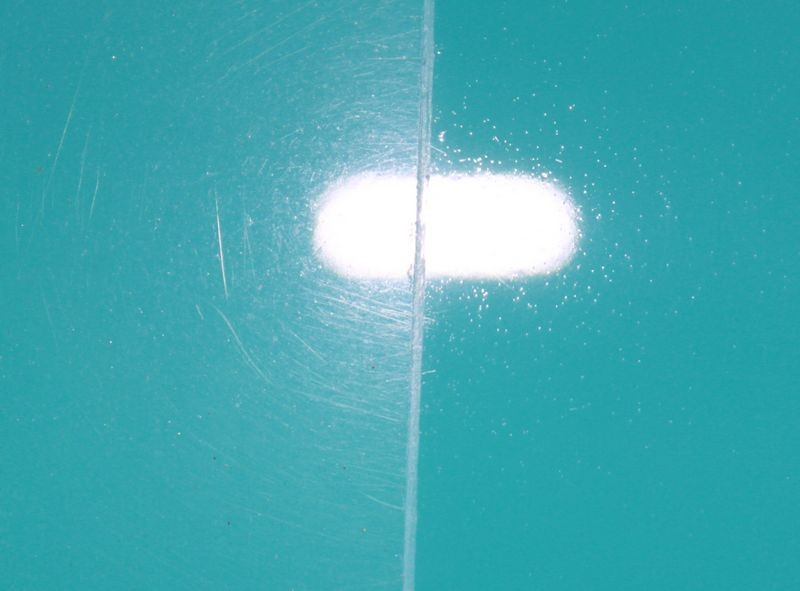 Thanks: 0
 Likes: 0
 Dislikes: 0
-
 "Working In" a Sealant? "Working In" a Sealant?
In a recent discussion about using a polisher to apply products, a question came up about whether to apply pressure or just let the weight of the polisher supply the pressure.
And yes, I know at least some pressure would need to be applied on vertical surfaces.
Anyway, a statement was made about applying pressure to "work the sealant in".
This was the first time I heard of needing to "work a sealant in".
Is there a benefit to doing this?
I can't think of any reason for it, but maybe I am missing something.
-
Super Member

Re: "Working In" a Sealant?
Some people do this...IIRC Totoland Mach does, but I could be way off. I never personally found a benefit in doing so; I use whatever pressure it takes to spread a thin, even layer across the paint...which usually isn't much.
-
Super Member

Re: "Working In" a Sealant?
 Originally Posted by CharlesW

A statement was made about "working the sealant in". I can't think of any reason for it, but maybe I am missing something.
I'm with ya there, the only thing I can think of is trying to ensure even coverage. As I understand it sealants are generally made of synthetic cross-linking polymers that adhere to the surface. Therefore not needing any "working" like, say, a polish needs to be worked. WOWAWOWA Wipe on, wait awhile, wipe off, wait awhile.
Care to post a link to the specific thread in the OP?
-
Super Member

Re: "Working In" a Sealant?
What are you "working it" into? Not like it's going "into" the paint. Like all LSPs, the key is uniform spreading or application of the product over the surface. Pressure is dependant on product and/or applicator.

Metro Detroit's Leader in Vehicle Preservation & Perfect Paint Finishes
-
Re: "Working In" a Sealant?
When you apply a wax or paint sealant you mostly just coat over the surface, but under a microscope the surface isn't 100% flat like you're eyes see, so the term working a wax or paint sealant into the paint just means to push the wax or paint sealant into the microscopic pits, pores, hills, valleys and interstices, which means microscopic cracks of fissures in the paint.
When paint is brand new, like a brand new car it is in it's most perfect solid condition possible or impermeable condition. With time, wear and tear the surface begins to open up with imperfections, it becomes more permeable.
It's not like older single stage paints that are a lot more porous but the idea is to seal the surfaces as best you can.
Personal preference, if you feel gliding a wax applicator pad over the surface once or twice is sufficient for your level of expectations for doing a good job of depositing the protection ingredients onto and into the surface then that's all you need to do.
As for me, I practice what I preach and I tell people when it comes to applying a wax or paint sealant to make 2-3 passes over each square inch to thoroughly work the wax or paint sealant over and into the paint TO WHATEVER LEVEL IS POSSIBLE.
You see with that kind of recommendation you will insure 100% of the surface is coated and protected to the best of a person's ability.
It's just a good "best practice"
When it comes to single stage paints then you can work a product into the paint as they are more porous than modern clear coats.
But everyone can find a method that works best for them...

-
Re: "Working In" a Sealant?
 Originally Posted by A4 1.8tqm

Care to post a link to the specific thread in the OP?
Just look for any post I've ever made about applying a wax or paint sealant.
Over 28,000 post on MOL so there's probably plenty of threads to find over there.
In two recent video we just shot I also make the recommendation to work the wax or paint sealant over the surface and into the surface to whatever level is possible.
Here's a picture of paint with surface imperfections that if -->you<-- were waxing this paint you would be pushing wax into these pinholes at least at some level.
From this thread,
1957 Chevrolet Belair Extreme Makeover - Flex 3401 & Wolfgang Smackdown!

Now in the above picture you can see the surface is not 100% smooth, but does this mean just because your eyes can't see any imperfections in the surface that there aren't any?

-
Re: "Working In" a Sealant?
 Originally Posted by Mike.Phillips@Autogeek

Here's a picture of paint with surface imperfections that if -->you<-- were waxing this paint you would be pushing wax into these pinholes at least at some level.
From this thread,
1957 Chevrolet Belair Extreme Makeover - Flex 3401 & Wolfgang Smackdown!

Now in the above picture you can see the surface is not 100% smooth, but does this mean just because your eyes can't see any imperfections in the surface that there aren't any?

Would working a sealant into the paint surface shown actually "fill" any of those imperfections?
I was always under the impression that the sealant would just coat the imperfections and not really make any improvement.
I also always felt that a wax did seem to do some "filling" in those type of blemishes.
Those look pretty bad in the picture and I wouldn't expect any product to do a lot for them.
While I don't apply sealants/waxes by machine, it would not be any great effort to do so if it was going to have a benefit.
It would also not be any great effort to "work" the sealant/wax in when applying it by hand.
Maybe if it ever quits snowing and warms up a little, I'll give it a try.
-
Super Member

Re: "Working In" a Sealant?
Seeing that the most products are liquid polymers, don't they bond together over the surface rather than inside microscopic voids? Do you actually need to push product into these spaces to create a bond?

Metro Detroit's Leader in Vehicle Preservation & Perfect Paint Finishes
-
Re: "Working In" a Sealant?
 Originally Posted by CharlesW

Would working a sealant into the paint surface shown actually "fill" any of those imperfections?
No. The idea isn't to fill them in but to coat or seal them but to do this you would have to push the wax or sealant into them, not just merely glide your pad over the surface.
Again everyone can apply their choice of wax or paint sealant however they want but it doesn't hurt to thoroughly work the product over and into the surface to whatever level is possible.
Key words being, whatever level is possible.

-
Re: "Working In" a Sealant?
 Originally Posted by David Fermani

Seeing that the most products are liquid polymers, don't they bond together over the surface rather than inside microscopic voids? Do you actually need to push product into these spaces to create a bond?
I'm not a chemist David?
You can apply wax however you wish... all I'm saying isn't doesn't hurt to do your best to thoroughly work your choice of a wax or paint sealant over and into the surface to whatever level is possible.

Similar Threads
-
By Dredogol in forum Auto Detailing 101
Replies: 18
Last Post: 08-05-2017, 07:53 PM
-
By Zune in forum Auto Detailing 101
Replies: 4
Last Post: 07-17-2017, 02:54 PM
-
By mdrees in forum Ask your detailing questions!
Replies: 7
Last Post: 06-05-2017, 10:59 PM
-
By austinz in forum Show N' Shine
Replies: 4
Last Post: 12-27-2015, 03:45 PM
-
By IID in forum New Car Care Products
Replies: 20
Last Post: 10-08-2012, 12:59 PM
 Members who have read this thread: 0
Members who have read this thread: 0
There are no members to list at the moment.
 Posting Permissions
Posting Permissions
- You may not post new threads
- You may not post replies
- You may not post attachments
- You may not edit your posts
-
Forum Rules
|
| S |
M |
T |
W |
T |
F |
S |
| 26 | 27 | 28 | 29 | 30 | 31 |
1
|
|
2
|
3
|
4
|
5
|
6
|
7
|
8
|
|
9
|
10
|
11
|
12
|
13
|
14
|
15
|
|
16
|
17
|
18
|
19
|
20
|
21
|
22
|
|
23
|
24
|
25
|
26
|
27
|
28
|
29
|
|
30
| 1 | 2 | 3 | 4 | 5 | 6 |
|












 Thanks:
Thanks:  Likes:
Likes:  Dislikes:
Dislikes: 

 Reply With Quote
Reply With Quote



Bookmarks